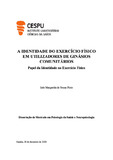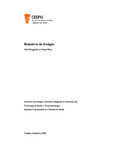| dc.contributor.advisor | LEITE, ÂNGELA MARIA TEIXEIRA | |
| dc.contributor.author | Pinto, Inês Margarida de Sousa | |
| dc.date.accessioned | 2021-07-23T14:18:33Z | |
| dc.date.available | 2021-07-23T14:18:33Z | |
| dc.date.issued | 2021 | |
| dc.identifier.uri | http://hdl.handle.net/20.500.11816/3636 | |
| dc.description.abstract | Assiste-se, gradualmente, a um aumento significativo a nível mundial do interesse e envolvimento no Exercício Físico (EF). Os tipos de exercício que promovem o fitness físico e afetam, de forma benéfica, a saúde do indivíduo e o seu funcionamento global, têm-se tornado aspetos fulcrais na vida das pessoas (Carneiro, 2012).
Além disso, também tem sido dado ênfase ao estudo de aspetos biopsicossociais relacionados ao EF. O papel da Identidade do Exercício Físico (IEF), conceito relacionado ao modo como o indivíduo desempenha o papel de “exercitador” como aspeto central da sua identidade, tem sido estudado dentro desta temática por vários autores (Ntoumanis et al., 2017; Anderson & Cychosz, 1994, 1995; Miller et al., 2002). A existência de uma forte identidade do EF apresenta-se como positiva para um desportista, pois quanto mais este se vincula à sua prática, mais importância, dedicação e compromisso vai colocar na prática (Chen et al., 2010). Também o estudo de determinadas variáveis relacionadas ao EF é importante de forma a entendermos melhor que fatores condicionam a intenção de praticar EF, que fatores condicionam a motivação para o exercício e que fatores influenciam as atitudes face à prática do mesmo.
Em suma, torna-se pertinente a continuação dos estudos no âmbito da IEF, pois, embora se observe um incremento da investigação nos últimos anos, o facto de se aumentar o conhecimento científico nesta área pressupõe desenvolver o conceito de identidade do EF a partir das bases já estabelecidas, preenchendo as lacunas existentes.
Este estudo explora as temáticas acima descritas através de dois manuscritos. O primeiro com o título “A identidade do exercício físico em utilizadores de ginásios comunitários: Papel da Identidade no Exercício Físico”, tem como objetivo principal, avaliar os aspetos biopsicossociais do EF em utilizadores de ginásios comunitários, nomeadamente no que diz respeito ao papel da identidade no EF. Os resultados deste primeiro estudo possibilitaram verificar que: a EIS correlacionou-se estatisticamente com todas as dimensões; a idade apareceu correlacionada negativamente à IPEF; foi verificada uma diferença estatisticamente significativa na Regulação Intrínseca cuja média foi superior no género feminino; foi verificada uma diferença estatisticamente significativa na AFEF, cuja média foi superior nos participantes solteiros; os participantes que têm personal trainer, apresentaram valores mais elevados no NSEF; os participantes que no seu treino em grupo fazem aulas de força apresentaram valores maiores no BREQ; os participantes que no seu treino em grupo fazem aulas de força apresentaram, também, valores maiores no EIS; os participantes que fazem no seu treino em grupo aulas de força apresentaram, igualmente, valores maiores no AFEF; os participantes que fazem treinos individuais apresentaram valores superiores no PCC e no AFEF; os participantes que não consumiam esteroides anabolizantes apresentaram valores mais elevados de regulação intrínseca e no NSEF; os participantes que não realizavam aulas corpo mente e aulas de força em grupo, apresentaram valores mais elevados de IPEF, NSEF, EPEF e amotivação.
O segundo intitulado “Adaptação da Escala de Identidade do Exercício Físico (EIS) a utilizadores de ginásios comunitários, tem como objetivo verificar se a Escala de Identidade do Exercício Físico- EIS (Anderson & Cychosz, 1994). Os resultados permitiram verificar que a EIS apresenta um bom modelo de ajustamento à população-alvo. | pt_PT |
| dc.description.abstract | There is gradually a significant worldwide increase in interest and involvement in Physical Exercise (PE). The types of exercise that promote physical fitness and beneficially affect an individual's health and overall functioning have become central aspects of people's lives (Carneiro, 2012).
In addition, emphasis has also been placed on the study of biopsychosocial aspects related to PE. The role of exercise identity (PEI), a concept related to how an individual plays the role of "exerciser" as a central aspect of his or her identity, has been studied within this theme by several authors (Ntoumanis et al., 2017; Anderson & Cychosz, 1994, 1995; Miller et al., 2002). The existence of a strong identity of PE presents itself as positive for a sportsperson, because the more he/she is attached to its practice, the more importance, dedication and commitment he/she will put into the practice (Chen et al., 2010). The study of certain variables related to PE is also important in order to better understand which factors influence the intention to practice PE, which factors influence the motivation to exercise and which factors influence the attitudes towards the practice.
In summary, it is pertinent to continue the studies within the scope of IEF, because, although an increase in research has been observed in recent years, the fact of increasing scientific knowledge in this area presupposes developing the concept of identity of PE from the bases already established, filling existing gaps.
This study explores the themes described above through two manuscripts. The first with the title "The identity of physical exercise in community gym users: Role of Identity in Physical Exercise", has as its main objective, to evaluate the biopsychosocial aspects of PE in users of community gyms, namely regarding the role of identity in PE. The results of this first study made it possible to verify that EIS was statistically correlated with all dimensions; age was negatively correlated with IPEF; a statistically significant difference was found in Intrinsic Regulation, whose mean was higher in females; a statistically significant difference was found in EFAF, whose mean was higher in single participants; participants who have a personal trainer showed higher values in NSEF; participants who in their group training do strength classes showed higher values in BREQ; participants who in their group training do strength classes also presented higher values in the EIS; participants who in their group training do strength classes also presented higher values in the EFF; participants who do individual training presented higher values in the PCC and EFF; participants who did not consume anabolic steroids presented higher values of intrinsic regulation and in the NSEF; participants who did not do body mind and group strength classes presented higher values of IPEF, NSEF, EPEF, and amotivation.
The second one entitled "Adaptation of the Physical Exercise Identity Scale (EIS) to community gym users, aims to verify if the Physical Exercise Identity Scale- EIS (Anderson & Cychosz, 1994). The results allowed verifying that the EIS presents a good adjustment model to the target population. | pt_PT |
| dc.language.iso | por | pt_PT |
| dc.rights | info:eu-repo/semantics/openAccess | pt_PT |
| dc.subject | Identidade no exercício físico | pt_PT |
| dc.subject | Ginásios | pt_PT |
| dc.subject | Aspetos biopsicossociais | pt_PT |
| dc.title | A Identidade do Exercício Físico em Utilizadores de Ginásios Comunitários - Papel da Identidade no Exercício Físico | pt_PT |
| dc.type | info:eu-repo/semantics/masterThesis | pt_PT |
| dc.identifier.tid | 202736717 | pt_PT |
| thesis.degree.name | Mestrado em Psicologia da Saúde e Neuropsicologia | pt_PT |


